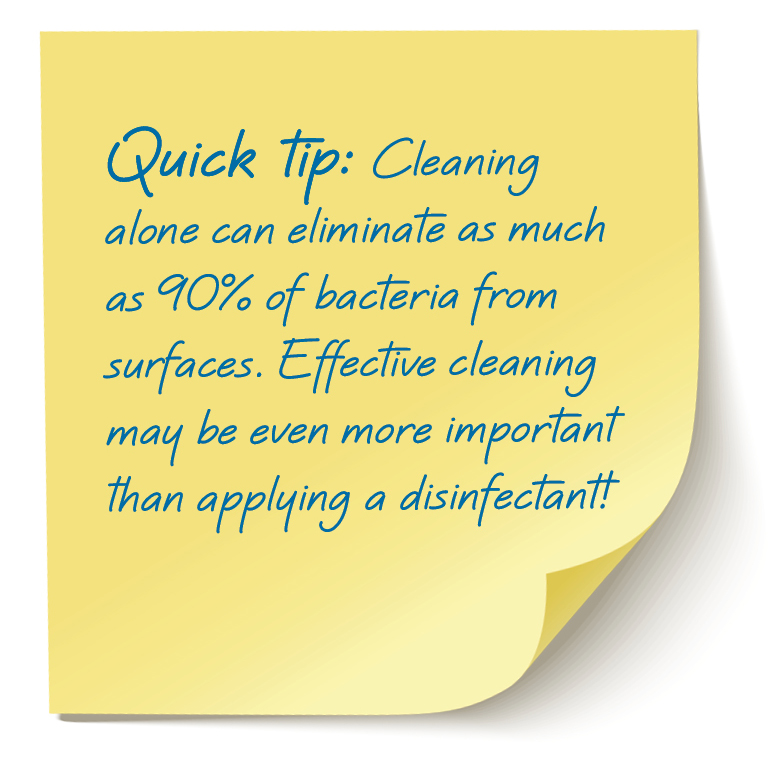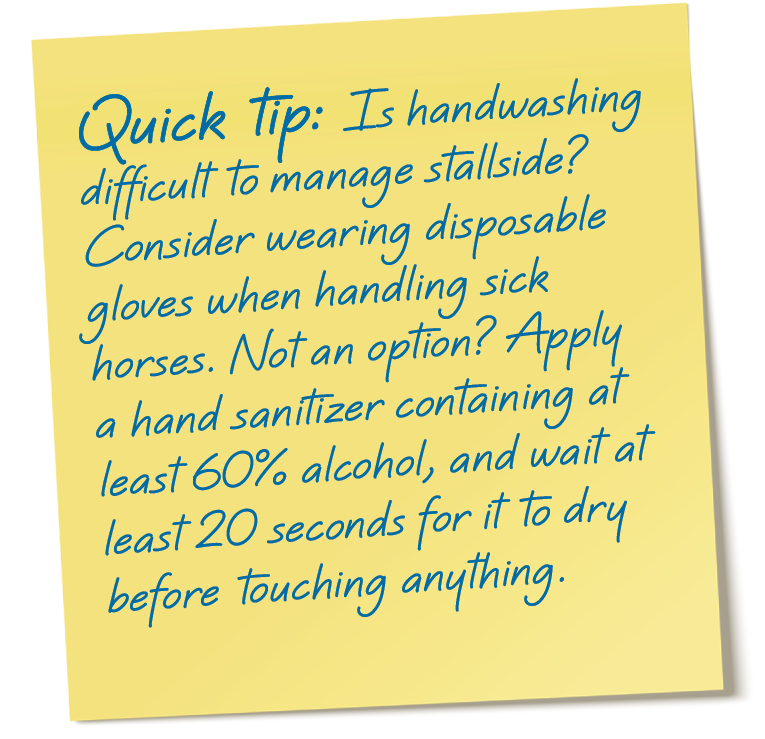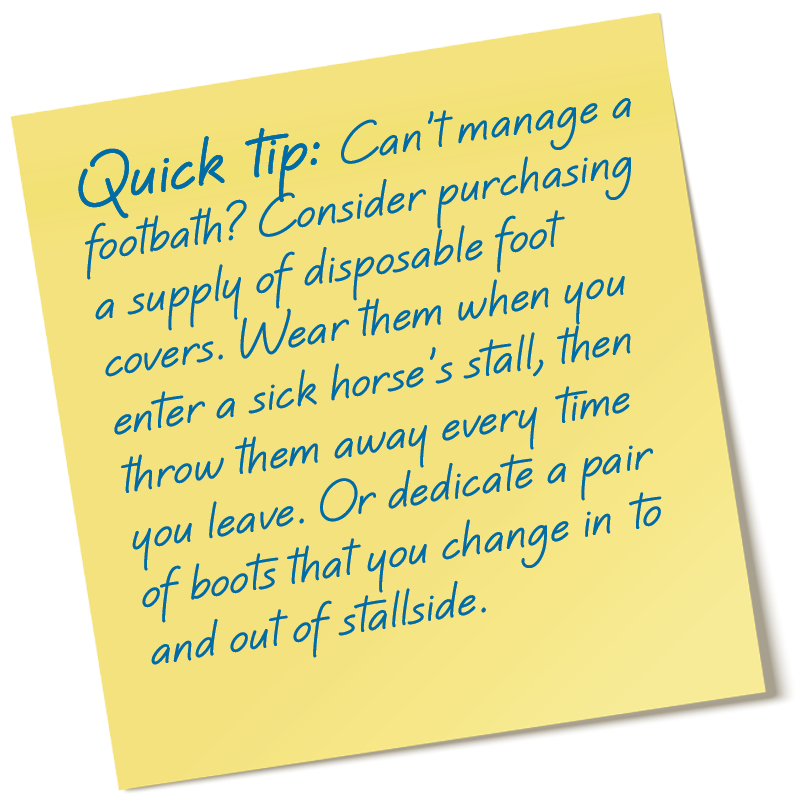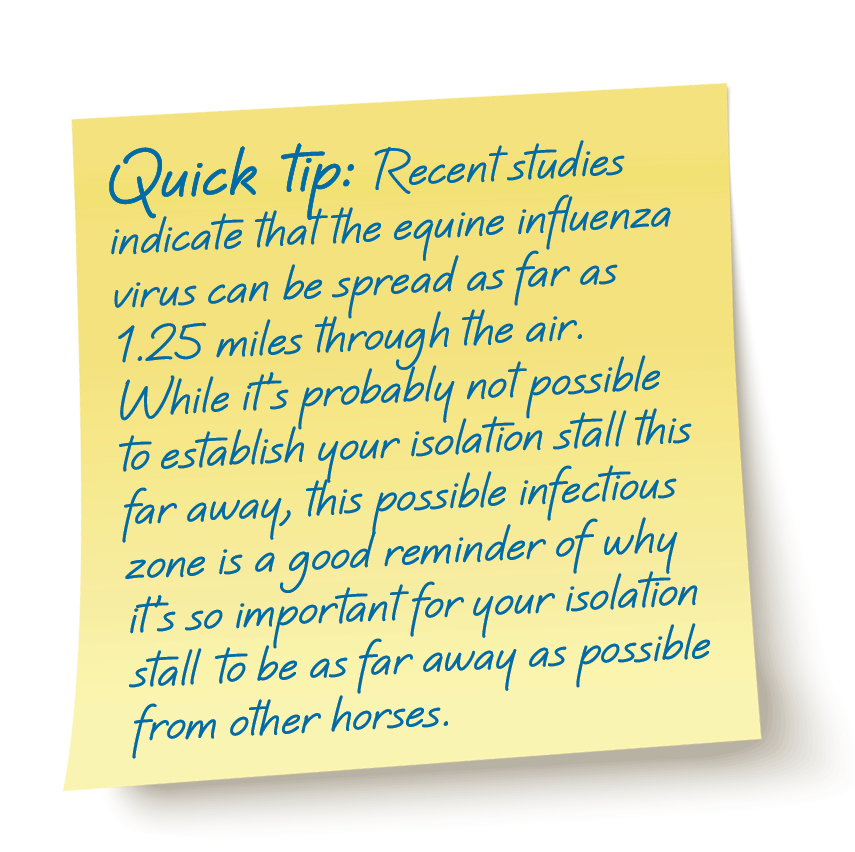If an infectious-disease outbreak strikes your barn, you’ll feel as though you’ve stepped into a hurricane. “Don’t touch that! Don’t go there!” your veterinarian will likely bark out, racing from horse to horse. As your vet races out the door, blood samples in hand, he or she will shout, “Isolate! Disinfect!”
[READ: WHAT TO DO IF YOUR HORSE IS EXPOSED TO DISEASE]
But where should you start? And how?
Here, I’ll tell you how to prepare for an outbreak. I’ll start with a list of basic items to have on hand. Next, I’ll give you a set of practical, step-by-step guides designed to control the spread of microorganisms. Finally, I’ll tell you how to correctly use key disinfectants.

How to Disinfect a Stall
If a sick horse leaves your barn, you need to effectively clean and disinfect his stall before allowing any other horse to enter. Also follow these steps before moving your horse into a strange stall at a horse show, horse hotel, or other off-site facility.
Step 1. Clean out the stall. Remove from the stall all feed, bedding, and equipment, such as water buckets and feeders. If you plan to return this equipment to the stall, set it aside to disinfect separately before doing so.
Step 2. Scrub the walls. Wet the walls from top to bottom, then thoroughly scrub them with a detergent, such as Tide. This will help loosen organic matter and debris, and will emulsify fats to make them easier to rinse away.
Step 3. Allow walls to dry. This is a critical step. Any moisture left behind will dilute the disinfectant you’ll apply next, rendering it less effective.
Step 4. Disinfect. Thoroughly spray all surface areas with an effective disinfectant. Lysol is a good choice if the walls are particularly manure-stained; it’s more effective in the face of organic material than other products. Bleach is a good alternative if the surfaces are very clean. The recommended dilution ratio is between 1:10 (1.5 cups of bleach per gallon of water) and 1:100 (0.25 cups of bleach per gallon of water).
Step 5. Clean buckets and feeders. Thoroughly clean and disinfect water buckets and feeders before returning them to the stall. Soak in bleach (diluted in the same ratio as in Step 4, above) or a 70% isopropyl alcohol solution for 5 minutes.
How to Wash Your Hands (Properly!)
Studies leave no doubt that handwashing is one of the most important steps you can take to help prevent the spread of disease. In fact, estimates say that up to 80% of infectious diseases are spread by touch. Follow these steps anytime you have to handle a sick horse.
Step 1. Wet your hands. Wet your hands under running water. Any temperature will do. Studies show that there’s no benefit to washing with warm water over cold. In fact, warm water is more likely to irritate your skin, especially if you hand wash frequently.
Step 2. Lather your hands. Lather all surfaces of your hands and under your nails with soap. Studies show that there’s no additional benefit to washing hands with antibacterial soaps, so any soap will do.

Step 3. Scrub your hands. Scrub for at least 20 seconds. The Center for Disease Control recommends singing the “Happy Birthday” song twice while scrubbing.
Step 4. Rinse your hands. Rinse your hands under clean, running water. Don’t rinse in standing water, or you’ll risk recontaminating your hands.
Step 5. Dry your hands. Dry your hands with a clean towel, or allow them to air dry completely. Estimates say that wet hands are 1,000 times more likely to transmit bacteria than dry ones.
How to Set Up a Footbath
If an infectious disease strikes your barn, one of the first recommendations you’re likely to hear is to set up a footbath outside of every sick horse’s stall, especially for diseases involving diarrhea or draining abscesses. Properly setting up and using a footbath will reduce or eliminate spread of disease-causing organisms on your boots or shoes. Here’s what to do.
Step 1. Situate the tub. Place a flat rubber or plastic feed tub on a level surface just outside the sick horse’s stall. Line the inside of the tub with a circular piece of synthetic turf. Place a long-handled scrub brush nearby.
Step 2. Dilute the solution. A proper dilution of Lysol (2.5 tablespoons of Lysol concentrate per gallon of water) is the best disinfectant option for a footbath, because organic material is an inevitable contaminant.
Step 3. Fill the tub. Fill the tub with the disinfectant solution to a level that will completely cover the bottom of a pair of boots or shoes; two to three inches deep is ideal.
Step 4. Brush off organic material. Every time you leave the stall, brush off as much organic material (bedding, feed, and manure) as possible from the soles and sides of your boots or shoes.
Step 5. Step into the footbath. Step into the footbath, and wipe the bottoms of your feet on the rough synthetic turf to remove remaining organic debris. When it comes to disinfecting, the longer you can stand there, the better. While no one is likely to stand in a footbath for a full 10 minutes, that’s the amount of contact time recommended for best results.
Step 6. Change the disinfectant. Keep the disinfectant fresh and uncontaminated to maintain the footbath’s effectiveness. Change the disinfectant at least once per day. If you notice a lot of accumulated organic material, change the disinfectant more frequently.
[READ: BIO-SECURITY MEASURES FOR YOUR HORSE]
How to Establish an Isolation Protocol
When a horse first shows signs of disease (such as a fever), the most important action you can take is to isolate him from the rest of your herd—and the sooner the better to avoid the spread of disease and a potential outbreak. Here are the steps to take.

Step 1. Assess location. Find the location of the sick horse’s stall. If he’s well isolated in a back corner of your barn and has limited contact with other horses, it might be acceptable to leave him there, but if it’s in the middle of the barn, move him out.
Step 2. Select an isolation stall. If you do need to move out the sick horse, select an isolation stall that’s as far away from other horses as possible and where you’ll be able to limit access. The fewer people passing by, the better. Don’t forget the barn pets. Cats and dogs can spread disease just as easily as humans. Ideally, find a stall near a water source (in addition to the sick horse’s waterer) for cleanup.
Step 3. Identify equipment. Identify any equipment that the horse has been in contact with—including brushes, buckets, and cleaning implements—to scrub and disinfect.
Step 4. Establish a footbath. Set up a footbath and handwashing station outside the isolation stall. Designate stall-cleaning utensils for that stall only. Use a separate trash can for manure and other waste.
Step 5. Cordon off the area.Cordon off the area to prevent access by anyone other than the veterinarian and designated caretaker. Mark a boundary around the stall with brightly colored duct tape. Put up visible signage at every access point to keep out all unwanted visitors.
Step 6. Assign a caretaker. Assign one person to care for the horse. Make sure this person understands the importance of using a footbath, washing hands (or using sanitizer), and keeping all equipment separated. Always handle healthy horses first, sick horses last.

How to Disinfect Grooming Equipment
An important part of barn bio-security is regularly cleaning and disinfecting grooming tools, not only during a disease outbreak but also for routine prevention of skin diseases caused by microorganisms that can easily be passed from horse to horse. Here’s how.
Step 1. Prepare disinfectants. For a large set of brushes, bleach is an excellent disinfectant option. Use hydrogen peroxide on very dirty small tools, as it’s effective against all microbial organisms, including spores. (It’s limited only by volume because it’s best used directly out of the bottle.)
Step 2. Remove debris. Physically remove all hair and other debris. Use your fingers, or run a comb through the bristles.
Step 3. Scrub. Scrub the brushes with soap and water. If they’re exceptionally dirty, use detergent to loosen caked-on dirt.
Step 4. Soak. Soak the brushes in disinfectant for a half-hour or longer, even if the disinfectant has a shorter effective contact time—that is, the time it needs to be in contact with the organisms to get a good kill. This will ensure the liquid penetrates the brush bristles and difficult-to-reach nooks and crannies.
Step 5. Allow to dry. Remove the brushes from the disinfectant solution, shake them out, and allow them to dry completely before using. Lay the brushes on their sides to protect the bristles, rotating them as necessary.
Disinfectants 101
As you clean, you’ll likely come across the statement, “Apply effective disinfectant, following the manufacturer’s label instructions.” But what disinfectant should you choose? And how should you use each product? You might be surprised to learn that common, inexpensive household products are excellent disinfectant options. Here’s what you need to know.
Option 1: Lysol Brand Concentrate. (Active ingredient, o-benzyl-p-chlorphenol). This phenol-type disinfectant is effective against bacteria, fungi, and most viruses. Not all Lysol Brand cleaners are the same, so read ingredient labels carefully. Lysol is slightly better in the face of organic material than other disinfectants, making it a good choice for footbaths and for spraying down stall walls.
How to use it: Dilute 2.5 tablespoons of Lysol Concentrate in 1 gallon of water. Recommended contact time is 10 minutes for optimal disinfection.
Option 2: Household bleach. (Active ingredient, sodium hypochlorite). Bleach is an effective disinfectant that kills bacteria, fungi, and viruses. It doesn’t work well in the face of organic material, so it’s best for disinfecting items that have been thoroughly cleaned. It can be hard on equipment and may cause “bleaching” discoloration.
How to use it: Household bleach is typically between 5.25% and 6.15% sodium hypochlorite. The recommended dilution ratio is between 1:10 (1.5 cups of bleach per gallon of water) and 1:100 (0.25 cups of bleach per gallon of water). Use a stronger concentration for more contaminated items. A weaker concentration is easier on equipment. Recommended contact time is five minutes.
Option 3: Isopropyl alcohol. Isopropyl alcohol (“rubbing alcohol”) is an effective disinfectant against most bacteria, fungi, and viruses. Alcohol isn’t usually the best choice for footbaths, because it evaporates rapidly, but it can be an excellent option for disinfecting most equipment.
How to use it: A 70% solution of isopropyl alcohol is recommended (mix 7 cups alcohol with 3 cups water). Recommended contact time is five minutes.

Option 4: Hydrogen peroxide. Hydrogen peroxide is actually one of the most effective disinfectants. It’s not only effective against bacteria, fungi, and viruses but also against bacterial spores. It’s a great option for disinfecting small pieces of equipment that may be heavily contaminated calling for a wide spectrum of antimicrobial activity. It can even enhance the removal of organic material and is considered one of the most environmentally friendly disinfectants. Avoid eye contact.
How to use it: Hydrogen peroxide is most commonly sold as a 3% solution, which should be used undiluted. Recommended contact time is 30 minutes.
[READ: MORE BIO-SECURITY MEASURES]
Your Clean-Up Kit
Be prepared to handle a potential infectious-disease outbreak with the following supplies.
⎭ Buckets. Keep several clean buckets on hand for scrubbing and soaking, and/or mixing disinfectant.
⎭ Flat feed tub. Find a flat rubber or plastic feed tub that’s large enough to step into for a footbath.
⎭ Synthetic turf. Cut a small roll of synthetic turf to fit the bottom of the feed tub when setting up a footbath.
⎭ Disposable gloves. Pick up a box of disposable latex or vinyl gloves to use when handling sick horses.
⎭ Handheld scrub brush. Find a scrub brush with hard bristles to use to pre-clean surfaces when you start your disinfecting protocol.
⎭ Long-handled scrub brush. A long-handled scrub brush is helpful for hard-to-reach areas, as well as for removing organic debris that may be caked on your boots before stepping in a footbath.
⎭ Laundry detergent. Laundry detergent, such as Tide, is ideal for scrubbing down and cleaning walls or equipment prior to disinfecting.
⎭ Brightly colored duct tape. Use tape to mark off “no entry” isolation areas.
⎭ Disinfectants. You’ll need several different disinfectants, such as Lysol concentrate, isopropyl (rubbing) alcohol, household bleach, and hydrogen peroxide.
⎭ Measuring cups/spoons. Round up a full set of measuring utensils so you can properly mix disinfectants.
⎭ Spray bottles. You’ll use a spray bottle to spray disinfectant on walls or other surfaces. Stash several in your clean-up kit.
⎭ Ivory soap. Ivory soap (or an equivalent) is a good choice for handwashing, because it doesn’t have any coloring, scent, or other additives.
⎭ Clean towels. Use clean towels to dry your hands after washing them.
⎭ Hand sanitizer. Pick up a few bottles of 60% alcohol hand sanitizer to sanitize your hands if a washing station isn’t available.






